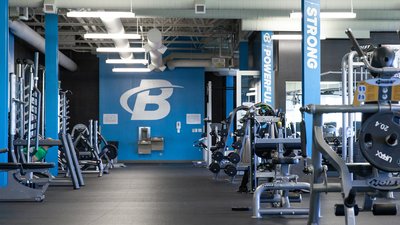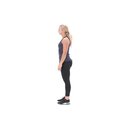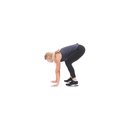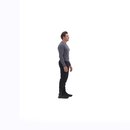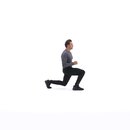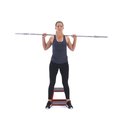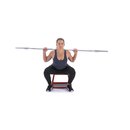The Question:
People workout their upper back so hard that they forget all the mass in the lower half. It seems that fewer people are training their lower back. Many people in the gym won't even attempt to do a deadlift.
What is the best lower back workout? Be descriptive (sets, reps, etc).
What is the importance of training the lower back?
Bonus Question: How can you improve your deadlift?
Show off your knowledge to the world!
The Winners:
- ravadongon View Profile
- N10ct View Profile
1st Place: ravadongon
The muscles located in the lower back region play a critical role in both athletic performance and overall aesthetic appeal for the bodybuilder. It would be an understatement to say these muscles are not worked enough, considering their importance in our lives.
Like a lot of muscles located in such places, i.e. all the muscle groups making up the posterior chain (lower back, glutes and hamstrings), it is often not trained because it is not visible in the mirror. This is the WRONG philosophy to adopt and if you are this type of person, then it's time for you to change your ways, and here is the perfect place to start...
Lower Back Anatomy and Exercises
Erector Spinae (spinal erectors)—this is the muscle group many people refer to as the 'lower back.' It forms part of the posterior chain, a term used for the muscles making up the region from behind the knee to the middle back, the most important group of muscles in the body.
Here is a brief summary of it's anatomy, showing the number of heads the muscle has, how the muscle articulates movement, where it is attached to the bones via tendon in both words and diagrammatically.
Here are some of the exercises which it is the target muscle. In all exercises that the spinal erectors are involved in, they are exercised "isometrically," meaning that the muscles contract against a force without their length being altered.
What Is The Best Lower Back Workout?
A good way to set up is in the following 3 ways. Personally, I set up my workouts in the Upper/Lower fashion, so my posterior chain work is done on my lower body days.
You cannot isolate the lower back, as performing exercises which it is used in, also work the rest of the posterior chain (it acts in these movements as a synergist or stabilizer of the movement), so it should not be included on a day of it's own i.e. a "lower back day."
Note I
Before all your workouts I encourage you perform a proper warm-up to prevent the chances of an injury occurring and also to allow 'loosen you up' and get you both mentally and physically prepared to perform at your best.
Here is a suggested warm-up:

BodyFit
$6.99/month- 2,500+ expert-created single workouts
- 3,500+ how-to exercise videos
- Detailed workout instruction
- Step-by-step workout tips
- Training at gym or at home
- Access to Workout Plans
- Access to Bodyfit App
- Store Discounts
Already have a Bodybuilding.com account with BodyFit? Sign In

What comes with BodyFit?

- Instructional Videos
Don't risk doing a workout improperly! Avoid injury and keep your form in check with in-depth instructional videos.

- How-to Images
View our enormous library of workout photos and see exactly how each exercise should be done before you give it a shot.

- Step-by-Step Instructions
Quickly read through our step-by-step directions to ensure you're doing each workout correctly the first time, every time.

BodyFit
$6.99/month- 2,500+ expert-created single workouts
- 3,500+ how-to exercise videos
- Detailed workout instruction
- Step-by-step workout tips
- Training at gym or at home
- Access to Workout Plans
- Access to Bodyfit App
- Store Discounts
Already have a Bodybuilding.com account with BodyFit? Sign In

What comes with BodyFit?

- Instructional Videos
Don't risk doing a workout improperly! Avoid injury and keep your form in check with in-depth instructional videos.

- How-to Images
View our enormous library of workout photos and see exactly how each exercise should be done before you give it a shot.

- Step-by-Step Instructions
Quickly read through our step-by-step directions to ensure you're doing each workout correctly the first time, every time.
Note II
Keep in mind with all your workouts, to always try and increase weight or repetitions on all exercises every session in the given rep range; i.e. say you did 6 reps with 250lbs on Romanian Deadlifts (given rep range is 6-12 reps), next session you want to go for more than 6 reps with 250lbs. Eventually you'll be able to do 12 reps with 250lbs on Romanian Deadlifts and at that point you should increase the weight by 10-15lbs.
1. Pull
Deadlift OR a variation of it (i.e. Deadlift—Trap Bar Deadlift, Snatch Grip Deadlift, Sumo Deadlift, Platform Deadlift):
- Work to 3-5RM
Sumo Deadlift:
- Upper Body Horizontal Pull (i.e. Bent Over Rows, Seated Rows, Face Pulls): 3 x 6-12
Face Pulls:
- Upper Body Vertical Pull (i.e. Weighted Pullups, Lat Pulldowns): 3 x 6-12
- Posterior Chain—Hip Extension Movement (i.e. Stiff/Bent Legged Good Mornings, Hyper-extensions, Pull Throughs, Romanian Deadlift, Reverse Hyper Extensions): 3 x 6-12
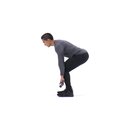
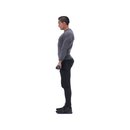

BodyFit
$6.99/month- 2,500+ expert-created single workouts
- 3,500+ how-to exercise videos
- Detailed workout instruction
- Step-by-step workout tips
- Training at gym or at home
- Access to Workout Plans
- Access to Bodyfit App
- Store Discounts
Already have a Bodybuilding.com account with BodyFit? Sign In

What comes with BodyFit?

- Instructional Videos
Don't risk doing a workout improperly! Avoid injury and keep your form in check with in-depth instructional videos.

- How-to Images
View our enormous library of workout photos and see exactly how each exercise should be done before you give it a shot.

- Step-by-Step Instructions
Quickly read through our step-by-step directions to ensure you're doing each workout correctly the first time, every time.
Suggested Schedule
- Mon: Legs and Abs
- Tue: GPP/HIIT Cardio/Off
- Wed: Push
- Thu: GPP/HIIT Cardio/Off
- Fri: Pull
- Sat: GPP/HIIT Cardio/Off
- Sun: Rest/Recovery (i.e. deep tissue massage)
Comments:
This is a good workout and split for those who like to train 3 days per week. With this workout, your posterior chain will be worked well, twice a week (it will also be worked on Monday), with sufficient rest between the 2 sessions, allowing for plenty of rest and time for growth.
2. Lower Body
Deadlift OR Squat or a variation of either (i.e. Squat—Box Squats, Front Squat, Wide Stance, Deadlift—Trap Bar Deadlift, Snatch Grip Deadlift, Sumo Deadlift, Platform Deadlift): Work to 3-5RM
Unilateral Leg Lift (i.e. Bulgarian Split Squat, Lunge Variations)
Bulgarian Split Squat: Hip Extension Movement (i.e. Stiff/Bent-Legged Good Mornings, Hyper-extensions, Pull Throughs, Romanian Deadlift, Reverse Hyper Extensions): 3 x 6-12
Weighted Abdominal Movement (i.e. Cable Crunches, Side Bends, Weighted Crunches): 3 x 8-15

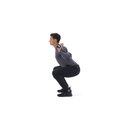

BodyFit
$6.99/month- 2,500+ expert-created single workouts
- 3,500+ how-to exercise videos
- Detailed workout instruction
- Step-by-step workout tips
- Training at gym or at home
- Access to Workout Plans
- Access to Bodyfit App
- Store Discounts
Already have a Bodybuilding.com account with BodyFit? Sign In

What comes with BodyFit?

- Instructional Videos
Don't risk doing a workout improperly! Avoid injury and keep your form in check with in-depth instructional videos.

- How-to Images
View our enormous library of workout photos and see exactly how each exercise should be done before you give it a shot.

- Step-by-Step Instructions
Quickly read through our step-by-step directions to ensure you're doing each workout correctly the first time, every time.
Suggested Schedules
- Mon: Upper
- Tue: GPP/HIIT Cardio/Off
- Wed: Rest
- Thu: GPP/HIIT Cardio/Off
- Fri: Lower
- Sat: GPP/HIIT Cardio/Off
- Sun: Rest/Recovery (i.e. deep tissue massage)
Or:
- Mon: Upper
- Tue: GPP/HIIT Cardio/Off
- Wed: Lower
- Thu: GPP/HIIT Cardio/Off
- Fri: Upper
- Sat: GPP/HIIT Cardio/Off
- Sun: Lower
Comments:
This is my personal favorite and in my opinion most productive workout for the posterior chain. It is easily adjustable for those who like less/more frequent training splits as it can be done 2 or 4 days per week. It covers all areas of the posterior chain development well in one session, and is quick while still being an incredibly intense workout.
3. Full Body
Deadlift OR Squat or a variation of either (i.e. Squat—Box Squats, Front Squat, Wide Stance, Deadlift—Trap Bar Deadlift, Snatch Grip Deadlift, Sumo Deadlift, Platform Deadlift): 5 x 5
Upper Body Push (Flat/Incline/Decline Bench Press, Weighted Dips): 5 x 5
Hip Extension Movement (i.e. Stiff/Bent-Legged Good Mornings, Hyper-extensions, Pull Throughs, Romanian Deadlift, Reverse Hyper Extensions): 3 x 6-12
Upper Body Pull (i.e. Bent Over Rows, Seated Rows, Cable Rows, Weighted Pull-ups)
Weighted Abdominal Movement (i.e. Standing Cable Crunches, Woodchops, Side Bends, Weighted Crunches): 3 x 8-15

BodyFit
$6.99/month- 2,500+ expert-created single workouts
- 3,500+ how-to exercise videos
- Detailed workout instruction
- Step-by-step workout tips
- Training at gym or at home
- Access to Workout Plans
- Access to Bodyfit App
- Store Discounts
Already have a Bodybuilding.com account with BodyFit? Sign In

What comes with BodyFit?

- Instructional Videos
Don't risk doing a workout improperly! Avoid injury and keep your form in check with in-depth instructional videos.

- How-to Images
View our enormous library of workout photos and see exactly how each exercise should be done before you give it a shot.

- Step-by-Step Instructions
Quickly read through our step-by-step directions to ensure you're doing each workout correctly the first time, every time.
Suggested Schedules
- Mon: Full Body
- Tue: GPP/HIIT Cardio/Off
- Wed: Rest
- Thu: GPP/HIIT Cardio/Off
- Fri: Full Body
- Sat: GPP/HIIT Cardio/Off
- Sun: Rest/Recovery (i.e. deep tissue massage)
Comments:
I understand a lot of people like to work the whole body in their sessions in the gym, which I don't have a problem with, as it can be beneficial for many as a change or a staple form of training.
This workout is incredibly intense (more so than the previous two, so beware!) on not just the posterior chain, but the whole body. If you are new to weight training, you might want to stay away from this for now, till you've built up your work capacity.
What Is The Importance Of Training The Lower Back?
A strong core (abdominal region) and posterior chain (lower back, glutes and hamstrings) is incredibly important for everyone because it binds together the upper and lower body during all athletic movements like sprinting and jumping.
The stronger an athlete is from the middle out, the more effective that athlete will be in any athletic competition. As Joe DeFranco, one of the best athletic strength coaches out there, says, the posterior chain is the "performance engine" of the body.
Being strong in both these areas will not only improve your athletic performance outside the weight room, it will also make you much stronger in almost all your lifts, as it acts as the posterior chain acts as a synergist or stabilizer in many weight lifting movements and make you much less susceptible to injuries in that region, which are very common, especially in older athletes.
Note:
It is important you pay attention to training both the abdominal region and posterior chain as muscular imbalances between the two can result in postural problems.
Bonus: How Can You Improve Your Deadlift?
If you get to a point where your deadlift has stagnated and you are no longer making gains you used to, best chances are, you are doing something wrong. Below, I have outlined the 3 main stages of the deadlift where people encounter problems and how they can solve these problems.
Bottom
Simply put this is about getting the weight off the floor. This is probably the biggest problem for most people as it has a lot to do with technique, something that many lifters get wrong time and time again with the deadlift.
Problems
Using a weight that is too heavy.
Poor set up positioning.
- Hips too high/low (distance from hips to bar increased—creating longer lever arm = "seemingly" heavier weight)
- Rounded back top (injury potential)/bottom (tight hamstrings OR weak core)
- Wide grip (further to pull)
- Shins too far away from bar (distance from hips to bar increased—creating longer lever arm = "seemingly" heavier weight)
- Taking too long in your set up (reducing assistance created from stretch shortening cycle—muscle's elastic components storing energy when stretched and then using that energy when the muscle begins to contract)
Too slow
Weak hamstrings
Solutions
Work with a lighter weight and progress at a steady rate, don't increase weight to fast and make sure you are using good form (see below)...
Good set up positioning
- Too high—Think about arching a little OR getting your 'rear end' down before every attempt. Too low—Use the posterior chain (it's much, much stronger than your quadriceps) by starting with higher hips.
- Top—keep a high chest OR (if that doesn't work) get your posture aligned (see a chiropractor). Bottom—stretch your hamstrings before deadlifting AND make sure you are training your core, with exercises like standing cable crunches, woodchops, hyperextension, bridges (standing exercises will generally yield the best results).
- Closer grip = less distance to pull. Your forearms should be brushing up against your legs.
- Get closer to the bar (though not to the point where it's uncomfortable with your shins are being ripped up by the bar).
- Do your preparation beforehand, not at the bar. Pull the weight up as quick as possible, don't waste the power created from the stretch shortening cycle.
Dynamic Effort Deadlifts (AKA Speed Pulls) OR Low Box Squats: 8 x 3 @ 50-65% of 1RM (45s - 60s rest)... concentrate on speed AND Raised Deadlifts (i.e. Deadlifts from a "deficit" —~4-6" is good)—Plate Deadlifts, Platform Deadlifts.
Hip Extension exercises: Stiff/Bent-Legged Good Mornings, Hyper-extensions, Low Cable Pull Throughs, Romanian Deadlift, Reverse Hyper Extensions.
Middle
At this point you have the weight 1/3 way up; you still have another 2/3 to go. If you can't get the weight up any further, your problems may be:
Problems
- Weak hamstrings
- Too slow
- Weak upper back
Solutions
- Hip Extension exercises: Stiff/Bent-Legged Good Mornings, Hyper-extensions, Low Cable Pull Throughs, Romanian Deadlift, Reverse Hyper Extensions
- Dynamic Effort Deadlifts (AKA Speed Pulls): 8 x 3 @ 50-65% of 1RM (45s - 60s rest)... concentrate on speed
- Horizontal Pulling (some vertical pulling is fine, but primarily horizontal): Bent Over Rows, Seated Rows, Face Pulls
Lockout
The weight is now 2/3 the way up, you're nearly there, you just have to lock it out now, but unfortunately it isn't that easy for some people.
Problems
- Weak gluteals
- Tight hip flexors
- Weak upper back
- Poor neck extension
Problems
- Hip Extension exercises: Stiff/Bent-Legged Good Mornings, Hyper-extensions, Low Cable Pull Throughs, Romanian Deadlift, Reverse Hyper Extensions (Full ROM is very important so you hit the gluteals hard)
- Dynamic Hip Flexor Stretches (i.e. walking lunges, running butt kicks, lying scorpion) and Bulgarian Split Squats
- Horizontal Pulling (some vertical pulling is fine, but primarily horizontal): Bent Over Rows, Seated Rows, Face Pulls and an exercise for the traps: Shrugs, Olympic Lifts
- Don't look down; stay focused on something above your eye line
Grip Training
Also your grip is incredibly important if you want a big deadlift. If you are serious about getting a big deadlift, along with some mighty forearms, I would consider adding some grip training into your weekly training schedule. Not only will a strong grip help you with your deadlift, it will also help in a lot of other lifts as well as outside the weights room.
-Best of luck, Ravadongon
2nd Place: N10ct
Just because it's behind you doesn't mean it's not important—Improving your lower back.
The lower part of ones back is one of the most important parts. Sure it's not glamorous or head turning like biceps or abs, but without a strong lower back you simply can't build nice abs and guns.
Laying the strong foundation for your body involves both abs and the back. So with further delay let's delve into the world of lower back performance.
Anatomy 101
This is always the boring stuff that everybody skips so I'll keep it brief. Simply put, when we refer to the lower back (as I do in this article); we are referring to the Erector Spinae, aka the spinal erectors.
These muscles of the lower back keep the spine erect (no PhD needed here) and form the upper most part of the posterior chain (which includes the glutes and hamstrings).
Although these muscles are known as the lower back, they attach all the way up at the neck and run the length of the upper body to the sacrum region. The muscles are also involved in the movement of not only the spine but also the neck.
What Is The Best Lower Back Workout?
The lower back is unlike a lot of other body parts. This is because it does not matter whether you are a powerlifter, bodybuilder or athlete, you should never train the lower back by itself. There are a few reasons for this but the two I like to give are:
The lower back is involved in almost every lift in the gym. Giving the back its own workout would be overkill.
Most exercises used to strengthen the lower back work other muscle groups as well. Therefore the lower back should be worked in with legs, lower body or hamstrings. Depending on your set up.
While there is no 'best' lower back workout, there certainly are some exercises which are the best to develop the lower back.
CAUTION 1: While these exercises are the best to strengthen the lower back, they are also the best exercises to injure and destroy your back. BE CAREFUL!!
CAUTION 2: Never use machines or any device for these movements that force the path of the bar (e.g. Smith Machines). Everyone is different and has different levels of flexibility etc, and forcing the path will result in injuries.
CAUTION 3: The techniques described here are very basic. Do further research before using these lifts and preferably get a qualified coach to assess your form.
Good Mornings
Possibly the most under used exercise by bodybuilders and athletes. This exercise is great for the lower back and hamstrings and will develop massive and thick spinal erectors. The performance is simple.
Set yourself up as you would when squatting and simply push your butt back. Keep going until your shoulders are almost level with your hips, but never to level or below. Simply drive through your glutes and return to an upright position.
For beginners I recommend never going above 5 reps per set while learning this movement as fatigue can cause loss of form and lead to injury. Good mornings should always be performed early in you posterior chain workout, preferably as the first exercise.
Some Ways To Implement Good Mornings Into Your Program:
- As a Max Effort exercise: 1RM or 3RM
- 5x5
- 3x6
- 3x3
- As a posterior chain exercise in an athletic program such as WSFSB or Designer Athletes.
Variations: Standing, seated, Zercher, safety bar, stiff-legged (Russian Deadlift).
Deadlifts
Another classic exercise that works almost every muscle in the body. Deadlifts are better known to lifters of all persuasions. In its simplest form, you simply bend over and pick up a loaded barbell off the floor. It is important to bend at the knees, not waist and maintain a neutral back throughout the movement.
Like good mornings, reps should be kept low especially for the beginners to this movement.
Implementation: As for Good Mornings
Variations: Conventional, sumo, rack, dimmel, snatch-grip, Romanian (discussed later), stiff-legged (discussed later), trap bar, platform.
Hyperextensions
Possibly the most common lower back exercise used in gyms today. Almost every gym has the appropriate "bench." The movement is simple. Hook yourself in, lower, rise, repeat. This exercise is best done unloaded until you can knock out a good 10-12 reps then slowly add and increase weight.
Once you get too strong for the 45lb plates you can add a barbell but it is vital to have great spotters. Make sure your head, neck and straight back are aligned and although the movement is called hyperextensions, DO NOT hyperextend.
Implementation:
- 3x8-12
- As accessory posterior chain work
Variations: 1-legged, reverse.
Stiff-Legged and Romanian Deadlifts
These movements are very similar in their execution and effect. Simply stand with a barbell at full arm length down (e.g. on thighs) and lower by pushing your glutes back (like good mornings).
For stiff-legged deads, you legs obviously remain straight with the bar traveling straight up and down from its starting position. For the Romanian deadlifts the bar remains in contact with your legs throughout the lift.
Implementation: Both are best used as accessory or secondary posterior chain/ hamstring work. Sets and reps as you please.
Variations: 1-legged.
These are probably the 5 best exercises for the lower back. You will notice they all are also used for other body parts. This exemplifies that the lower back is part of a chain of muscles which must not be weak at any point.
While others might suggest the reverse hyper and pull through should be on this list, I feel the movements I mentioned hit the lower back better and the reverse hyper and pull through are much more glute and hamstring orientated.
Bonus Exercise:
Here is one no ever thinks of—The Hip Flexor stretch. Most lower back pain is caused by tightness in the hip flexors. This is caused for a number of reasons such as sitting in a chair for long periods. Simply performing a stretch on the hip flexors for 30 seconds several times per day will see a great improvement in your lower back health.
What Is The Importance Of Training The Lower Back?
The lower back is one of the most important body parts for athletes, powerlifters and bodybuilders alike. Just think how many people complain about having bad backs. Along with the abdominal group of muscles the lower back muscles are also a part of the "core" of your body.
Some like to refer to this area as the foundation which all is built on. While many people train abs religiously, they forget about the lower back, which is a recipe for disaster. Any muscular imbalances anywhere in the body must be avoided, but in particular between the abdominals and lower back. Imbalances here can lead to serious and career threatening injuries.
In every lift you do in the gym, the lower back plays a role. Maximizing the strength and health of the lower back will lead to improvements in everything from squats to curls, while reducing the chance of injury.
Powerlifters need to strengthen the lower back because it plays a vital role in all three of the powerlifts while athletes need it because it is part of the posterior chain, the main region of the body responsible for speed.
Bodybuilders know just how impressive thick erectors are on stage and need to strengthen the back not just for the gym but also for when they get oiled up. Even everyday folk, who aren't necessarily competing in any events or sports, will find benefits in their everyday life from strengthening their lower back.
Bonus: How Can You Improve Your Deadlift?
The deadlift is arguably the greatest lift of all. Sure bench pressing gets a lot of attention in most gyms but if you really want to separate the men from the boys (or women from girls), the deadlift is number one. It also is probably the most primitive of all lifts. Basically all you do is bend over and pick up a huge amount of weight. No fancy equipment needed, just something to lift. As the old saying goes, "Dip, grip and rip."
Deadlifts, while so very simple, offers so much to trainees. Firstly, it hits almost every muscle group in the body. For mass building purposes this is a huge plus. Some even rate dead's as high as squats on the best exercises for mass.
Secondly, from an athletic point of view, deadlifts work the posterior chain very well, and depending on which method of deadlifting you use you can target the 'chain' even more.
Why is this good for athletes? Well, simply put, the posterior chain is where speed comes from. If an athlete's chain gets stronger, with all else being equal, they will get faster.
Finally, and this is pretty obvious, deadlifts are of vital importance to powerlifters. The old expression is, "The meet doesn't start until the bar hits the floor."
Deadlifts with contests (from local to state to world titles)—if you can't dead with the best you won't win.
So how does one improve their deadlifts? Various issues need to be addressed these include: gear, technique and good old grunt work.
1. Gear (Equipment, Not Drugs)
Modern powerlifters seem to live for their gear, and whoever can coax the most out of their gear tend to be the most successful. The deadlift is the odd lift out of the powerlifting 3. While it is very possible to gain 50-100lbs out of a bench shirt or squat suit, most lifters get very little if anything out of any suit while deadlifting.
Even the big boys in the 900lb + range all wear soft suits which aren't increasing poundage's. Bottom line: supportive suits are not going to increase poundage's enough (20lbs+) to warrant using them.
An often overlooked type of equipment is shoes. Deadlifts should be performed barefoot, or if your gym owner won't allow it, in deadlift slippers. Minimizing the distance between the ground and your feet, helps to shorten the distance the bar has to travel, which should help you to lift more.
Wearing shoes also inhibit a strength reflexor in the foot, which will also improve performance. If you must wear shoes Converse Chuck Taylor's are a good option due to their flat sole.
2. Technique
While deadlifts can and have been described as 'dip, grip, rip', there is a fair amount of technique work needed to not only avoid injury but also increase poundage's.
Firstly, you need to analyze your current technique and assess whether or not it is helping you achieve your goals. If your goal is to be moving the most poundage, as the question here suggests, you need to decide which of the two main deadlift types are most advantageous for you.
The Conventional Deadlift: This is the most common deadlift you will see in gyms, powerlifting meets etc. For this style you legs will be about shoulder width apart, with your arms outside your legs as you grip the bar.
The Sumo Deadlift: For this method you place you legs MUCH wider and your arms hang down between your legs. Sumo deadlifts are also much easier on the lower back as you are in a much more upright position and the distance the bar travels is much shorter.
Experiment with these two techniques and see which one works best for you. Deadlifts are like benches and squats in what works for one lifter may not work for another.
It is most important, no matter which technique you go for, to learn it and master it before climbing up to heavy poundage's. While a good deadlift can strengthen you lower back, a bad one can destroy it leaving you on the sidelines for many years.
3. The Grunt Work
Simply put, to improve your deadlift poundage's, you don't need to deadlift. Many of the world's best powerlifters train at the Westside Barbell Club, where they rarely if ever deadlift.
The training methods they use to improve their squats carry over into their deadlifts (e.g. training spinal erectors and posterior chain). Heavy good mornings, box squats, glute-ham raises, reverse hypers and dynamic box squats all carry over to the deadlift.
For those of you who want to specifically train the deadlift to improve it, first you must assess your weaknesses. The two methods of assessment I will discuss are neuro-dynamic testing and sticking points.
Neuro-Dynamic Testing:
For this assessment you need to test for your 1RM in the deadlift. Not only will you need to record the poundage, but you will also have to time the lift.
The results will help place you in the following:
Neuro-Rate Dominant:
If your max takes less and 2.5 seconds from floor to lockout, you are more than likely neuro-rate dominant or speed dominant. Basically this means you are a hit or miss lifter. You might lift 500 lbs in 2 seconds, which is fast, but no matter how long you try and pull never hit 510 lbs.
If you fall into this category you need to improve you neuro-duration or strength. Basically, you need to learn how to "strain" and fight for a lift. Isometrics of various descriptions and heavy slow lifting is valuable for these athletes.
Neuro-Duration Dominant:
If your max takes a while longer, say over 5 seconds you are probably neuro-duration or strength dominant. This means that you 'strain' during your lift and may take you a long time and a lot of struggle to get.
If you fall in this category you need to become faster in your lifting. Dynamic box squats and deadlifts with bands are just what the doctor ordered.
If you fall in-between these categories you can follow a more balanced routine, or address a specific sticking point as discussed below.
Sticking Points:
There are three universally recognized sticking points during the deadlift, with literally dozens of articles on the internet addressing them. I will give you a brief overview of these points and how to improve them, but for more detail just look around and you'll find plenty of info.
Being too slow is major problem. This can be a problem at all sticking points. Dynamic lifts are used by powerlifters to blast through sticking points, no matter where they occur. Perform 8 sets of 1 rep at 70% of max. Perform 1 set every minute and use bands it available.
Also, since the posterior chain works as a chain, it is only as strong as its weakest link. In most cases this is the hamstrings, but can also be the glutes or lower back. Improving strength in these areas will also improve your deadlift (just like the WSB trainees).
1. The Bottom Of The Lift.
At the bottom of the lift, from the floor to half way up the shins, many things can go wrong. These include:
- Too much weight: lighten the weight.
- Too tight in the hip flexors and can't get deep enough: stretch the hip flexors in your warm-up.
- Poor glute activation: perform some glute activation exercises as discussed earlier.
2. The Middle Of The Lift.
This is between the shins and mid-thigh.
The most common problem in this region is a lack of speed. You really need to accelerate through this range of motion. Again dynamic deads are the way to go.
Also as we move closer to lock out the glutes become increasingly involved. Improving their strength and activation will help the lift.
3. Lockout
Lockout is basically all about the hip extension and snapping forward of the glutes. As long as you get through the first two-thirds with a bit of speed, locking out should be a simple as extending your hips.
Working the glutes and focusing on lockouts in a power rack are the best ways to improve your lockout.
Conclusion
These have been just a few ways to analyze and improve you deadlift. Experiment with a few things and watch your poundage's fly. Hopefully you can use the information in this article to improve and protect you lower back, no matter what your training goals are.
-N10CT
[ View The Other Responses! ] View This Week's Topic


